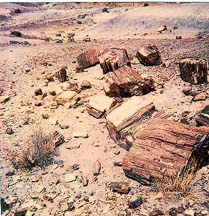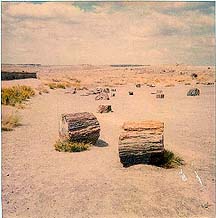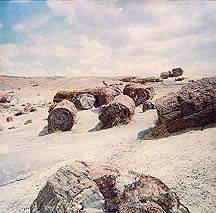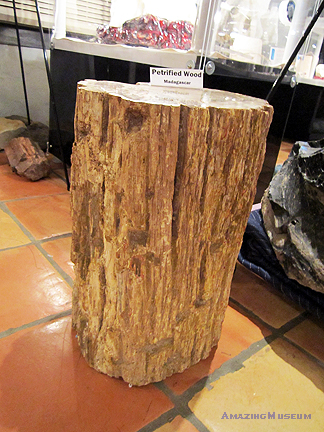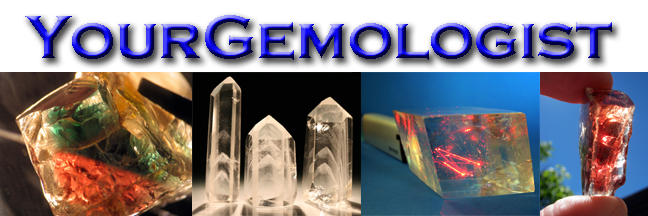
|
|
Petrified Wood |
Nothing is more fun that to be walking across a field and find a piece of petrified wood. Because it tells a story of a beautiful tree that once existed perhaps millions of years ago. and it has been preserved in its original shape and look for you to enjoy millions of years later. But the question is: How does wood last so long? How can it become so hard that it can last for millions of years? Well, the answer is easier than you may think. Wood that has been preserved is said to have been petrified. That being, that there is actually no wood left in the piece. The wood died and was gone many years ago. What you are actually seeing is where minerals have replaced the wood, but in the same shape and form. So that while you see the wood just as it looked millions of years ago, it is actually a rock that has taken the form of the wood. How does this happen? Let's get in our time machine and go back a few millions years ago...... |
We are going to go back in time 100 million years to a tropical forest in what is now the State of Texas. Just about 30 miles from my house. And while this part of Texas is now arid and many miles away from the Gulf of Mexico, once upon a time it was a lush green tropical paradise with huge conifer trees growing all over the place. These tree are extinct today but they once flourished throughout the area. At some point in time the climate changed and the trees died. They fell into a marshy swamp area and were quickly covered up. The watery mud that covered them was rich in calcium, and eventually, when the water dried up, the calcium filled in where the wood once existed and those conifer trees became petrified wood, or calcified wood, which ever you want to call it. Let's look at how the process worked...and at some examples.... |
We start out with a tree...like the one at left....living happily on a much warmer tropical earth almost 100 million years ago. As time goes by the tree gets old, or the weather changes, and it dies and falls into the mud. Here is where our story picks up............ |
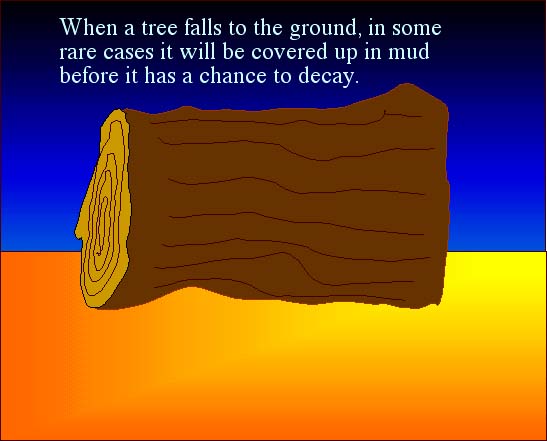 |
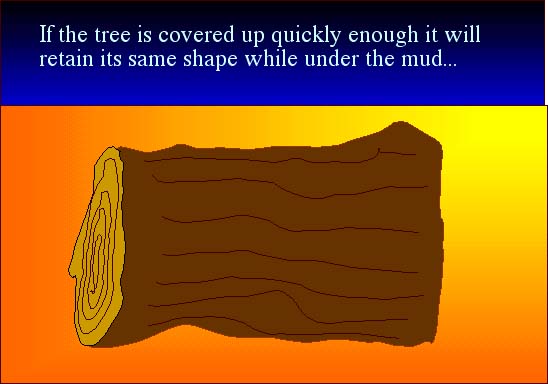 |
 |
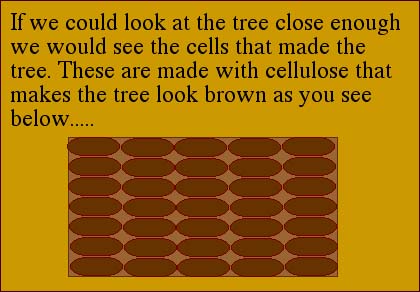
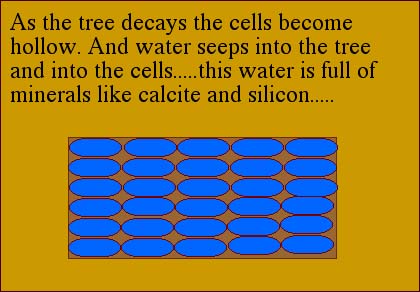


|
Below you can see an example of a calcified
tree that is still white. This is a type of petrified wood that
has had all of the wood cells replaced with calcite mineral.
And since we just uncovered this tree stump, it is still white.
After exposure to the ultraviolet light of the sun for a few
years, the petrified tree stump will start to turn dark. |
Freshly uncovered calcified tree with growth rings. |
If you look at the specimen below you will see a very well formed and well preserved conifer tree stump. It is dark because it was exposed to sunlight for many years. But notice how well you can see the growth rings still preserved. Although this stump is pure calcite mineral now, it still has the same shape and look of the tree stump when it died. With appreciation to Rey and Carol Castro of San Antonio, Texas on whose property this and many other specimens were found and donated to YourGemologist.com. It was my pleasure to work with Rey and Carol to dig a lot of these specimens up on their ranch. We really appreciate their help with YourGemologist.com. |
 Calcified
conifer tree stump from Texas Calcified
conifer tree stump from Texas |
Another view of the tree. Notice the 12 inch ruler on the floor. |
| One interesting point of this conifer tree is that the inside has growth rings like a modern tree, but the outside has a grainy texture like a palm tree. Below is a close up of the outside layer of the tree stump...just like it looked 100 million years ago when it died. |
Surface of the tree stump |
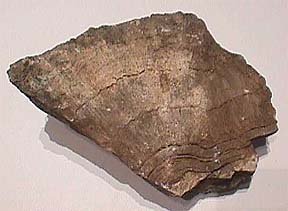 Cross section
of a piece of calcified wood Cross section
of a piece of calcified wood |
 Another
freshly uncovered calcified tree Another
freshly uncovered calcified tree |
| Below you see a cross section of a piece of calcified, petrified wood. The white dots at the red arrows are actually small glitters of shiny crystals that were difficult to photograph. However, these are actually well formed calcite crystals that are in the grain of the wood itself. Let's go on and look at some of these under the microscope..... |
 Cross section
of calcified wood Cross section
of calcified wood |
| In the first microphotograph below you see the red arrows pointing to the tiny but well formed calcite crystals that make the piece of wood. Actually, the entire piece is pure calcite where the calcite has replaced the wood material. The darkness you see in the photograph above is due to discoloration due to sunlight. Below and up close you can still see the white color of the calcite. |
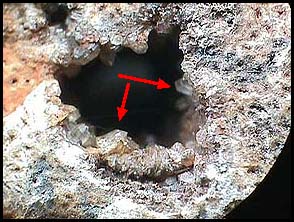 |
| Below is another view of the same specimen shown above. Here the red arrows point to very nicely formed calcite crystals that have grown inside the wood grain. These specimens are courtesy of Greg Albrecht and were found on his ranch in south/central Texas. I appreciate his allowing us to learn from these specimens. |
 Well formed
calcite crystals Well formed
calcite crystals |
| And, of course, the most often seen petrified wood has been replaced with silicon instead of calcite. Like the Petrified National Forest in Arizona. Here the water was full of silicon and it was silicon that replaced the wood and is now what you see. As you can note from the specimen below, you get a much more realistic look with silicon based petrified wood because the calcite turns the wood white...the silicon keeps natural looking colors. It is also this type of silicon created petrified wood that forms many major opal deposits. Since opals are silicon and water, that is the exact same ingredients that make petrified wood. So most silicon based petrified wood is really opals of various forms and qualities. |
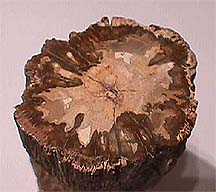
|
| Below is a nice look at a piece of petrified palm tree. The important difference of this type of petrified wood is that the wood itself is porous just like the original formation. Compare this piece of petrified palm tree with the other petrified wood on this page... |
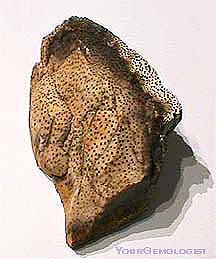 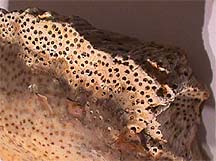 |
| Below you will see some photographs from the Petrified National Forest in the United States that I took on a drive from Miami to San Francisco. You will notice that these were originally very large trees when they were alive. They lived in an area of a swamp, and when they died they fell into the swamp and were quickly covered up. As a result they were preserved until they silicon in the water could replace the cellulose of the wood as it decayed. The result is that the wood became petrified as you see below. And as erosion slowly exposed the ancient petrified forest, it appears that tree were uncovered as you can see below. Here are a few views of the wonderful occurrence of petrified wood..... Please remember the all of the trees you see below are almost 1 meter in diameter. |
Petrified Tree Stump |
A petrified tree that has broken into segments... |
Large parts of petrified trees litter the countryside... |
A place where large trees once lived. Each is about 1 meter in diameter |
We hope you enjoyed our look at petrified wood. As you can see, there is a lot more to it than just a piece of wood. At left you see a petrified log from the island nation of Madagascar. This log is almost 2 feet tall and weighs over 200 pounds. |
|
|
|
© Copyright 2024 All Rights Reserved. Please read the fine print below: The information contained in this website is offered free of charge to anyone wishing to learn more about gemology. The information may be downloaded by any student, consumer, or jeweler for your own personal study and use. None of this site can be downloaded for posting on another website or server for any reason. It will be a violation of the copyright for anyone to copy, duplicate, distribute, and/or re-print this material in any format or any medium without written permission. Nor can anyone post this information on a for-profit website without written permission. That will ruin it for everyone and cause the entire site to be erased and canceled. Please honor this copyright for the good of everyone else. Robert James FGA, GG.....YourGemologist |
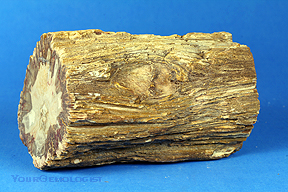
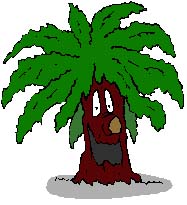
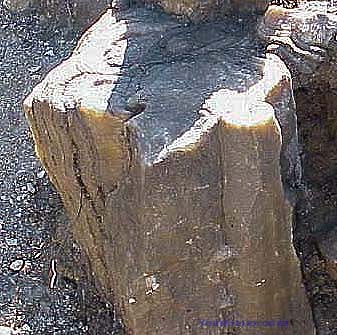
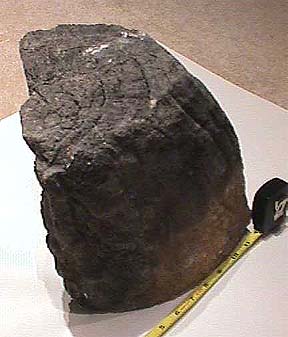

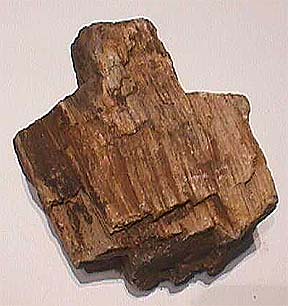 Chunk of silicon based petrified
wood
Chunk of silicon based petrified
wood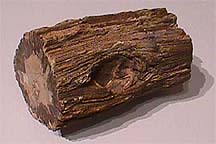 A nice piece of petrified tree
limb
A nice piece of petrified tree
limb
